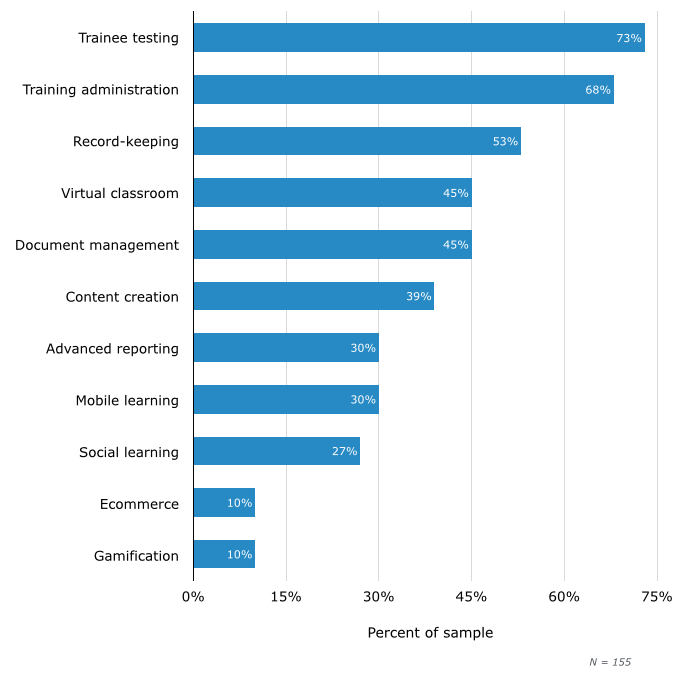With rapid transition from the era of science to era of technology, world today witnesses the dissemination of information. All old school forums change to the new, up-to-date and user-friendly platforms introducing ease in every task at hand. With the information breaking its conventional confinements to hard copies, their teaching methodologies needed a revision, too. And to ensure this compatibility came in a wide variety of software systems, the most widely accepted and used being LMS i.e. Learning Management System.
The reason for this widespread use and scalability of the software systems lies in its purpose and functionality. Namely, they deal with the management, administration, backtracking, reporting and supervision of any educational course, training program, or e-learning task. Providing a uniform environment for all attendees with loads of trainee and instructor efficient features, the use of LMS has been accepted as one of the international best practices, not only in the education sector, but also in the corporate paradigm. In fact, the unexpectedly well-performing application of this software deployment into the business industry has set up new success trends in employee management and training.
Gone are the days now, when emailing resources and social media groups served the purpose of virtual learning. Moreover, gone are the days when HR had to worry about each employee individually. Just group them correctly in an LMS batch and the trained LMS will get to them all, in the same uniform way, irrespective of their task settings, synchronous or asynchronous. With the inception of LMS and similar software systems, the e-learning industry seems to have reached new trends in terms of both education and profit.
The benefits of using learning management software
1. Task Assessment
The main usability of an LMS lies in the ease it provides for planning, executing, and assessing a specific learning process. With a separate login id for every user, provided with a grouped working environment to help share all resources with all groupmates in the session, it helps the user to track and record his own contribution along with the contributions of other peers for the same task. For the users with instructor roles in the LMS, additional features to supervise the progress of the task have also been implemented solving the deadline compliance and attendance issues in a pretty simple way.
2. Remote Collaborative Working
Another remarkable feature of LMS is respecting the users’ workspace needs and catering them for grouped working. Through the introduction of LMS, the need to be physically present with the groupmates to share the idea and work on it in a grouped fashion is eliminated. The groupmates can effectively communicate through the built-in chat room (both grouped and individual) to allow efficient discussions. Moreover, the easy-to-use file sharing features furthermore eases the remote working. Some top-notch LMS have been found to use embedded version control systems to furthermore remove the difficulties felt in grouped working, especially remotely.
A close look into the corporate domains reveal that this practice has also helped speeding up the task progress manifolds. With the supervisor several thousands of miles away: guiding, helping and reviewing the progress in a virtual environment, the tasks could never be this handy before!
3. Employee Records Maintenance
The key concern every instructor has, is the interest of his employees or his students in the learning process. This interest is the real driving force which makes their work unique and different from others’ work. So, LMS provides this additional feature to the instructors to help track the engagements and interactions of the attendees with the course content and educational resources. It also guides them better regarding the interest trend of the attendees which in turn leads them to better redesigning of course, in the best interest of the attendees as well as the instructor/ host.
Similarly, for the business trainees, the engagement and interaction of employees with the resources acts as a clear depiction of their active/passive role for their dedicated tasks and serves as a warning before the company loses that employee or his task deadline. This way, the statistics help the department managers preempt the upcoming situation. Then, they will be able to take necessary actions to avoid the adversities that can be caused, before they actually happen!
4. Outreach Expansion
The list of every software application benefits starts with the transcendence of physical presence or geographical barriers. That's what helps keeping the world at a click’s distance. On the same ground, with the deployment of software systems in learning processes, people with diversified work experiences and expertise stepped in on a single task and made wonders. This is the sole reason how the e-learning industry grew to its present magnitude, as seen today. Conducting paid and premium webinars for people from all over the globe is now the new educational trend. Similarly, video conferencing, virtual meetups for product review and quality assurance are the new norms of e-learning, all thanks to competent Learning Management Systems. Thus, for every new course designed, the whole world acts as an audience and hence the revenue generation grows manifold.
5. Decentralization of Resources
The checklist of a learning process begins with the resources and their efficient sharing with the attendees. For learning processes flooded with attendees, this easy task seems like a mess. As a result, many human errors can be caused in the process. To avoid them all, LMS seems to be pretty effective. It instantly shares all the resources selected with the attendees. Even for a new attendee added in between the course, the trained LMS can easily serve them without causing a hassle or extra burden for the instructor. Especially in cases that support asynchronous learning, this feature of LMS can be extremely relieving for the instructor. Thus, deployment of LMS not only keeps the learning process motivating and updated. It also lowers the manpower required to manage the course on the backend, acting as an automated tool to manage all of it, all by itself.
The Application of Learning Management Systems
Educational Institutions
LMS was initially designed for educational purposes and is found to be fit for its purpose. Most of the institutes use it as a platform for resource sharing among a class, a section or even a batch. The built-in chat room helps the students to get along with the peers. They can discuss their queries or confusions through a dedicated forum. This chatbot is also helpful for outside class student-teacher interaction. Especially, without sharing any excess contact detail of any of the two. Other than this, the latest LMS equipped with virtual video conferencing and virtual chat room facilities are also helping promote remote online lectures in case of commitments leading to physical absence.
According to Capterra research, the education industry constitutes only 21% of LMS users. Tech, manufacturing, healthcare, and consulting industries also make up large chunks of LMS users.
Enterprises
Just how with a high position comes a high responsibility, similarly with a high market position comes the task to manage hundreds and thousands of people and have them onboard with the corporation’s decisions to ensure smooth workflow. For this very task, LMS plays its best part bringing people closer and making interactions in a professional environment easier. Most of the businesses can have virtual meetups set up through such software instead of formal board of directors meetings. Users can easily record these virtual meetups, too, making it convenient to lock the minutes of the meeting. Moreover, surpassing physical barriers also speeds up the process and for business, time is money!
Small to Medium Businesses
LMS was originally designed to help support and complement the education sector. But it is amazing how it got more applications for itself, worth mentioning in this regard is the business paradigm. And not only the high scaled enterprises as discussed earlier, but even for medium and small businesses too. The importance of LMS for employee training and management programs have already been discussed. Other than these, LMS efficiently deals with the feedback recording, deadlines compliance, departments’ performance measurement and task delegation among departments, offices and employees, making it a necessity for proper working of business companies.
Common use cases

1. Employee training
To combat the changing market trends, companies tend to increase or vary their skillset. This is where employee training and courses come into action, and to support them, comes in the LMS. The way already discussed, LMS has proved to be an essential component in effective management and regulation of these training programs and courses.
2. Compliance training and onboarding
For every recruit, it's essential to familiarize him with the existing norms and traditions of the company, its prevalent products and services, its environment and work ethics. All of this comes under the umbrella of compliance training and onboarding. And it works effectively thanks to an implemented learning management software; acting as a single, wholesome resort in case of all ambiguities faced. In this way LMS finds its importance being the go to forum for every newly recruited employee.
3. Customer training
Just as profitable it seems, there’s more inside to the e-learning hosting sites, starting with LMS being the initial requirement. For such customer training sites, to track, record and manage enrollments of a massive scale of customers, it’s necessary to have some management software. And LMS serves the purpose aptly. Handling and serving the customers in an equally efficient fashion; in both synchronous as well as asynchronous environments, LMS seems to save the site admin from all sorts of hassle and human errors that may cause inconvenience to the customers.
4. Complementing Classroom learning with e-learning
Just like face-to-face learning carries its own benefits, so does the concept of e-learning. At the same time, it makes it hard to decide which one’s better than the other. However, the best practice isn’t choosing one of the two, but picking the advantages of both and grouping them in a unique model. Such is the methodology of top-class institutions these days, making them attend the old school conventional classroom lectures combined with an LMS helping them interact with the instructors remotely in a convenient way.
Essential features of a top-notch Learning Management System
Reviewing the currently existing LMS delineates the fact that as of yet, LMS don’t have a set of defined features, instead every company/ institution deploying LMS looks for features it feels to be necessary. Still, survey reveals that a few features are the essential necessities for an LMS, which are as follows:
- A Virtual Class Environment – Implementation of online video/audio lectures service.
- Individual and Group Chat Rooms – Group and solo chat threads for effective inter- role and intra-role communication.
- Feedback Recording Options – Features to evaluate user experience through feedback.
- Resources Management Software – Features for efficient organization and support of resources.
- Version Control Software – Software to keep a track of multiple versions of the same file to avoid mishaps.
- Data Storage Capacity – Options to allow the user to store his own files/ folders.
- Personalization Feature – Help user to set up the LMS display and settings in a way he finds convenient
- Easy Update Features – Coherency with all updated OSes and their features.
- Technical Support – Support desk implementation for technical issues, if any.
- Multi-Lingual Support – Language changing and translating option to help cater the needs of maximum audience.
Summary
Concluding the whole article, an LMS or a Learning Management System is an integral software that helps to ensure smooth working of learning processes, be it for educational institutes, corporate HR processes or even the e-learning industries. The reason for the importance of this software lies in the fact that it is dedicatedly designed for this purpose. The features implemented not only ease the admin side but also the client side making it fit for use. Moreover, depending upon the situations of use, you can alter it enough to support both, peer to peer and server client architecture. Sharing just the right amount of alteration autonomy with the admin, it gets even more easy to deploy an LMS.
With the world rapidly switching to remote working and remote learning transgressing physical bounds, LMS is the new essential and unavoidable need for all learning processes.
Try a new Learning Management System
Automatically migrate to a new platform right now




